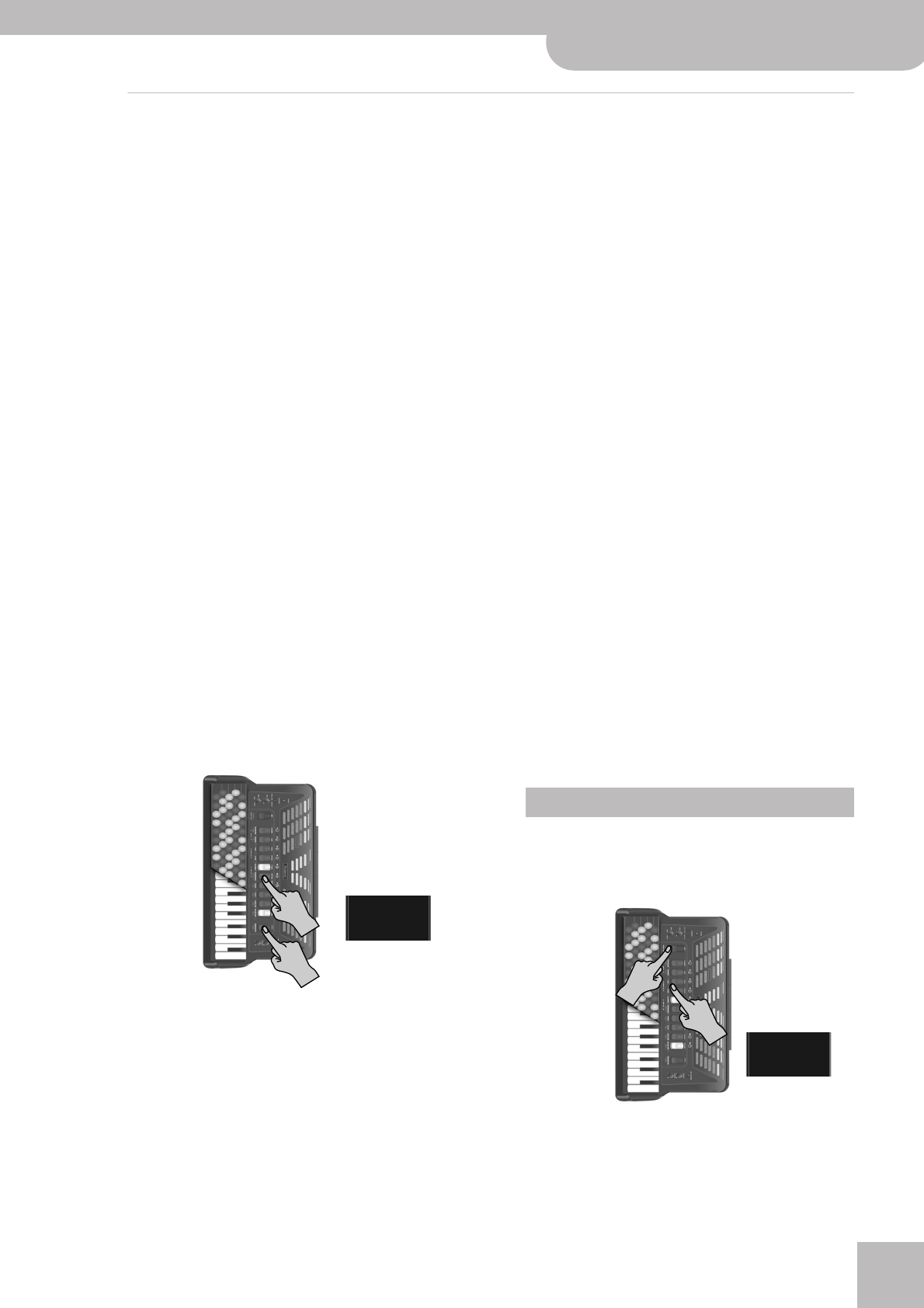
Sending program change messages when necessary
V-Accordion
r
53
Sending program change messages when necessary
(
bPC
,
C00
,
C32
)
Though each register or Set can transmit a program
change/bank select cluster when pressed (see “Program
Change TX” on p. 52), you can also transmit sound
select messages on the fly – without changing registers
on the FR-3. These are MIDI messages that cause an
external instrument or device to select a different
memory (i.e. another sound or effect).
This functionality is mainly intended for selecting set-
ting groups of various sounds on external instruments.
Such setting groups may be called “Performances” or
“Multis”, which you may want to select while playing,
because using those multitimbral memories has the
advantage that all sound addresses and MIDI channels
are configured “automatically” simply by sending the
correct “PC” address from the FR-3.
As the first half of the name (“Send PC”) suggests, this
function only transmits messages to an external device
whose MIDI IN port is connected to the FR-3’s MIDI
socket.
Here is how to take advantage of that function:
(1) Connect the FR-3’s MIDI socket to the MIDI IN port
of the module, synthesizer, etc., you wish to con-
trol.
(2) Set the “MId” parameter (page 50) to “Out”.
(3) Set the module’s MIDI receive channel (often
called “RX”) to “13”.
See its manual for details. If you are unable to
change the receiver’s MIDI channel, set the FR-3’s
“Control Ch” to match the external instrument’s “RX”
channel. See “Control Channel TX” on p. 52.
(4) Hold down the [ORCHESTRA÷MODE] register while
pressing register [6] (SEND PC).
(5) Use Treble registers [1]~[0] to enter the sound
number.
You may have to look in the owner’s manual of the
module or synthesizer you are controlling to find
out which number you need to transmit for the
sound (or memory) you want to select. You can
enter any number from “1” to “512”.
The [0] register acts as “0” here. To enter “502”, for
example, press registers [5], [0], and [2].
(6) If necessary, press the [SET] register to erase the last
entry you made.
If you entered “55”, for example, while the second
figure should have been a “2”, press [SET] once (so
that the display indicates “--5” again), then press
register [2] (“-52”).
Note: The FR-3 uses a smart entry system: after entering “52”
(or “53”, “54”, “55”,… “59”), you can’t add a third figure,
because the highest number supported by the SEND PC func-
tion is “512”.
Note: The [SET] button has two functions here: when pressed
lightly, it deletes the last entry you made (“backspace”). By
holding it for ±1 second, you delete all figures and start again.
(7) Press the [ORCHESTRA] register to transmit the
number you entered.
Bear in mind that despite the function’s name (“Send
PC”), the value you enter here is not really a program
change number, but rather the memory number used
by the receiving device.
“502” therefore refers to Performance number 502 of
the receiver, but that number cannot be conveyed as
such via MIDI.
The MIDI standard provides only 128 program change
numbers (for selecting memories) and two messages
called “Bank Select” that allow you to select 128
banks each. Two bank addresses (“MSB” and “LSB”)
with 128 possibilities each, plus 128 Program Change
numbers provide 128 x 128 x 128 values= 2,097,152
possible memories.
The numbers you enter on the page shown above
should therefore be taken to mean “memory XX of
the receiving device”. But how does the FR-3 then
convert it to a MIDI address that conforms to the
CC00/CC32/PC format (each of which supports a
maximum of 128 possibilities)? Enter the following
parameters:
(1) Press and hold the [SET] register until the display
shows a parameter name, then release it.
(2) Use register [5÷√] or [6÷®] to select the following
parameter.
“bPC” is short for “Send Bank PC TX”.
(3) Use register [1÷–] or [2÷+] to select the memory
group whose “real” MIDI address you want to
define.
The possibilities are: “1” (1~128), “2” (129~256),
“3” (257~384), “4” 385~512.
SPC
Defining the ‘PC’ format
bPC


















